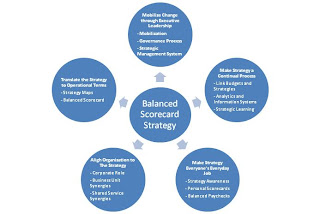The Strategy-Focused Organization
By Rian A.S.
The ability to execute strategy was more important than quality of strategy itself. This term could be accepted because of many Top Management could propose very good strategy but just only 10% could generate into actions.
World companies realize tangible asset on 1982 valued 62% of industrial organizations but recently it accounted 10-15%. Obviously, opportunities for creating values shifting from managing tangible asset to intangible asset such as customer relationships, innovative products and services, information technology and databases and employee capabilities and motivation. One most-known company that could be said as the best in managing intangible asset is Yahoo company (internet search-engine company).
The Balanced scorecard derives strategy into 4 broad perspectives; financial, customer, internal business processes and learning and growth. Those perspectives cover all relevant information for continual improvement that company purposed.
The figure draws the principles of a strategy-focused organization
By Rian A.S.
The ability to execute strategy was more important than quality of strategy itself. This term could be accepted because of many Top Management could propose very good strategy but just only 10% could generate into actions.
World companies realize tangible asset on 1982 valued 62% of industrial organizations but recently it accounted 10-15%. Obviously, opportunities for creating values shifting from managing tangible asset to intangible asset such as customer relationships, innovative products and services, information technology and databases and employee capabilities and motivation. One most-known company that could be said as the best in managing intangible asset is Yahoo company (internet search-engine company).
The Balanced scorecard derives strategy into 4 broad perspectives; financial, customer, internal business processes and learning and growth. Those perspectives cover all relevant information for continual improvement that company purposed.
The figure draws the principles of a strategy-focused organization

Principle 1: Translate the Strategy to Operational Terms
The strategy in balanced scorecard helps company to unleash potential capabilities that probably were hidden within old organization. By helping The Balanced Scorecard, those capabilities either tangible or intangible are collect and blend together into one or several focused-strategy. The Balanced Scorecard provides a framework to describe and communicate strategy in a consistent and insightful way.
Strategy Maps combines with Balanced Scorecards address the shortcomings of measurement systems. The measurements linkages of cause-and-effect relationship in strategy maps show how the intangible assets are transformed into tangible (financial) outcomes.
Principle 2: Align the Organization to the strategy
Assuming performance of the motor vehicle, all parts have their own purpose and strategy. For example spark plug ignites fire to burn gasoline with oxygen help from purified air intake. With helps from others machine components such as tires, car body, steer resulting car that could be driven into defined destination.
Motor vehicle analogy is exactly the same as company activities, purchasing department provides on time-delivery of purchased materials, logistic department ensures all products arrive at agreed time and venue, production department produces best product quality to offers into market by marketing department.
The challenge from top management is how to combine organizations with own knowledge, language and culture into one strategy. One driver should synergize all company capabilities and drive them to achieve agreed target.
Principle 3: Make Strategy Everyone’s Everyday Job
This step requires skill on how to roll-down strategy from boardroom into backroom and thus to front-line of daily and customer services. Strategy-focused organizations require that all employees understand the strategy and conduct the strategy into daily basis activities in regards to support success of the strategy.
How to put the strategy into everyone’s job is a question that could be answered by the Balanced Scorecards concept. By cascading strategy from top management into its subsidiaries is one way to communicate the strategy itself.
Successful organizations linked incentive compensation to the Balanced Scorecard. Most executives give reward to team that achieves points stated on Balanced Scorecard satisfactorily.
Principle 4: Make a Strategy a Continual Process
For most organizations, the management process is built around the budget and operating plan. The monthly management meeting is devoted to a review of performance versus plan, an analysis variance of past performances and action on dealing with those variances.
Daily meeting even just for 10-15 minutes is proved effective to control the “big picture” of the strategy. The result and information that collect from daily meeting is used to review strategy and make a relevant adjustment.
For most organizations, the management process is built around the budget and operating plan. The monthly management meeting is devoted to a review of performance versus plan, an analysis variance of past performances and action on dealing with those variances.
Daily meeting even just for 10-15 minutes is proved effective to control the “big picture” of the strategy. The result and information that collect from daily meeting is used to review strategy and make a relevant adjustment.
Principle 5: Mobilize Change through Executive Leadership
The first four principles focus on the Balanced Scorecard tool, framework and supporting process. It is important to stress that all strategy requires continual attention and focus on the change initiatives and performance against targeted outcomes. It requires too energetic leaders of the process to lead change.
The Balanced Scorecard is not a “metric” projects; it is a change project, a project that opening minds of every employees that company could significantly grow through Financial Perspectives’, Customer Perspectives, Internal Business Process Perspectives and Learning & Growth Perspectives.
(Kaplan & Norton)
Continued
No comments:
Post a Comment